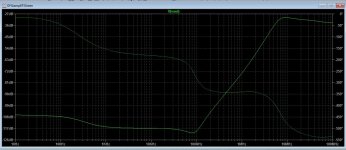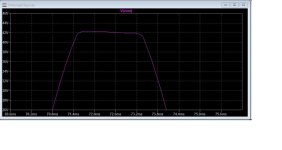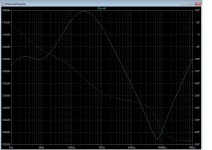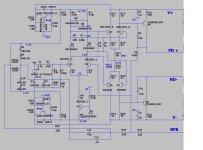Very nice. You can safely loose the ripple eaters between the VAS and output stage. You could also simplify it by removing the DC servo chip and extra capacitor and still get comparable performance but let AB listening tests decideIs there any interest in another design ? I will use Stuart's IPS standard but ALSO design a single pair power device stereo OPS board.
The advantages of the hellraiser.
-PSRR is quite superior. -120db easy. Single supply will match a monoblock wolverine.
-NO caps (just input cap) in audio (or DC) FB . servo can make for uV offset - LED CCS's are controlled by servo.
-300V/us slew - I don't know whether this would be audible , but - what the hell ... FAST !!
-A small 300W SMPS would make for a quite small and accurate 60w/ch amp with plenty of headroom (100w+ peak).
-this design seems to have the same 8-10ppm regardless of freq./ load - could this be the current FB ?
-not as many silver mica caps.
disadvantages -
-warm 1W feedback resistors , you will waste a whole watt .. ha ha !
- It MIGHT approach Wolverine THD - plugged into "fireanimal's" 4 pair Sanken EF3.
- Typically , complimentary ips's cancel even order harmonics. But , the odd's are so low it don't matter.
Seems a quite ideal endeavor as far as a design. Even if there is no interest - I shall have it.
below I have a FINAL schema to layout what ( I ) want. Off to the Sprint layout.
PS - this is a "branch" of the "Wolverine build thread" , I will make any design adaptable to the "wolverine EF3" , but
have no great interest in that thread. I want to at least match that design's performance with different topologies , but also want to
include our poorer hobbyist's in this project.
The "Wolverine EF3" is actually a modified HK680 (Slewmaster) OPS. I really don't have any rights to it ,but neither does anybody else.
I'm glad it was tested to the very limits of testing. COOL ! So , I will use it to to it's limit - I still can make it more robust ...
OS
Last edited:
Don't like servo's , neither do I. But this one just shifts the Vf's of the red LED CCS's , setting the diamond pair. No signal (corruption) involved.
I suppose I could just make one of the CCS's adjustable , as I do on my new spooky. Or , I could emulate that 1V CCS LED offset with
diodes strings and a pot (Wolverine tech).
I DO like always having uV offset at any frequency without having an evil servo tainting my audio path. It just seemed convenient , as I
already have the 12V supplies available. The cap multipliers are already on the Wolverine boards by default. If (WHEN) I make a 60W X2
board , I still might include them as 2 channels will run from a unified supply.
Hellraiser/Spooky are complimentary designs , natively they ARE ripple eaters enhanced by NFB , channel separation should be stellar.
On the 2 channel board .... even a very conservative multiplier (47u) won't take up much real estate.
(Below) WITHOUT the ripple eaters. -117db with 2V + 180phase 2V simulated rail ripple. Quite good.
Ripple eaters only reduce 3db from 1khz to 100Khz , but extend -120db+ down to 10hz.
Wolverine definitely can't do this without large ripple eaters. The Spook is similar to this.
Natively , this amp is perfect for multichannel single supply setups (and a single tiny 300W SMPS).
OS
I suppose I could just make one of the CCS's adjustable , as I do on my new spooky. Or , I could emulate that 1V CCS LED offset with
diodes strings and a pot (Wolverine tech).
I DO like always having uV offset at any frequency without having an evil servo tainting my audio path. It just seemed convenient , as I
already have the 12V supplies available. The cap multipliers are already on the Wolverine boards by default. If (WHEN) I make a 60W X2
board , I still might include them as 2 channels will run from a unified supply.
Hellraiser/Spooky are complimentary designs , natively they ARE ripple eaters enhanced by NFB , channel separation should be stellar.
On the 2 channel board .... even a very conservative multiplier (47u) won't take up much real estate.
(Below) WITHOUT the ripple eaters. -117db with 2V + 180phase 2V simulated rail ripple. Quite good.
Ripple eaters only reduce 3db from 1khz to 100Khz , but extend -120db+ down to 10hz.
Wolverine definitely can't do this without large ripple eaters. The Spook is similar to this.
Natively , this amp is perfect for multichannel single supply setups (and a single tiny 300W SMPS).
OS
Attachments
Here is the spooky V2 , since i was asked about it. It says "Bass Amp " .... as it's superior PSRR makes it ideal as a
Subwoofer plate amp.
Another killer advantage is the clipping -" tubelike" with the Hawksford's. Hellraiser uses the Spook VAS - same deal.
WOW , 20-200hz spook with NO ripple eaters proves this topology IS a ripple eater natively. No wonder the Leach amp
could run with a BS PS. This also would give audibly superior bass performance , you would hear this as much more definition.
Edit - look at the 20k-100Khz rejection .... this is the ripple of a typical SMPS. What a perfect match.
Subwoofer plate amp.
Another killer advantage is the clipping -" tubelike" with the Hawksford's. Hellraiser uses the Spook VAS - same deal.
WOW , 20-200hz spook with NO ripple eaters proves this topology IS a ripple eater natively. No wonder the Leach amp
could run with a BS PS. This also would give audibly superior bass performance , you would hear this as much more definition.
Edit - look at the 20k-100Khz rejection .... this is the ripple of a typical SMPS. What a perfect match.
Attachments
I full of (Ideas / shi$) today . But , how about a dual use stereo OPS board that could also be a sub amp. We are modular.
2 X 2 for 70W X 2 (stereo) .... or use all 4 for a 250W Bass plate. On audio was right , I CAN ditch the ripple eaters with these designs.
OS
2 X 2 for 70W X 2 (stereo) .... or use all 4 for a 250W Bass plate. On audio was right , I CAN ditch the ripple eaters with these designs.
OS
Nah , I don't need as much power these days. 200W for the hungry sub and 60W X 2 for the satellites.
I playing with ESP32's/preamps/lightshows and such. I do want a 60W/channel amp !! he he.. I'll have one.
I can make full class D amps now... what do I need G/H for. ESP32 controlled class D , anyone ?
I still like A/B - EF3 , it has more bass definition than D does.
I playing with ESP32's/preamps/lightshows and such. I do want a 60W/channel amp !! he he.. I'll have one.
I can make full class D amps now... what do I need G/H for. ESP32 controlled class D , anyone ?
I still like A/B - EF3 , it has more bass definition than D does.
And big linear supplies , too ? I do notice a weakness with using SMPS. Non-symmetrical designs have poor HF PSRR ,
especially >30khz.
BTW , some class D amps are quite clean. In some ways they might be a better match to SMPS , they have both active and passive
cancellation above 50khz.
especially >30khz.
BTW , some class D amps are quite clean. In some ways they might be a better match to SMPS , they have both active and passive
cancellation above 50khz.
I haven't had time to dig deeply into SMPS yet. I've tried a couple Connex supplies but had lots of noise issues with them. Lot's of radiated garbage with them and they could use better output filtering.
Most Class D amps I've seen have distortion numbers that take off above 1kHz. My hearing is like it has a notch filter from 600-1100 Hz. It's actually more sensitive than most in higher frequency range. Cut's out the nagging girlfriend noise but sucks for listening to music! I'm sure my hearing aids must be class D for better battery life so not all class D can be bad.
Most Class D amps I've seen have distortion numbers that take off above 1kHz. My hearing is like it has a notch filter from 600-1100 Hz. It's actually more sensitive than most in higher frequency range. Cut's out the nagging girlfriend noise but sucks for listening to music! I'm sure my hearing aids must be class D for better battery life so not all class D can be bad.
SMPS noise is like "nagging girlfriend" noise. That's freakin' funny. Class D is like a nagging wife. A/B is like the faithful family dog.
Everybody retreat to the "man cave" with lockable door.
Yes , that is why I've taken an interest to HF PSRR in these designs. The Connex seems cheaper. Soft- switching it is not.
PS - HF ESR sucks with some electrolytic caps. If using a SMPS , I'd check my sourcing carefully (on the amps) .... lowest 100k esr ,
Faraday cage the SMPS , as well.
Everybody retreat to the "man cave" with lockable door.
Yes , that is why I've taken an interest to HF PSRR in these designs. The Connex seems cheaper. Soft- switching it is not.
PS - HF ESR sucks with some electrolytic caps. If using a SMPS , I'd check my sourcing carefully (on the amps) .... lowest 100k esr ,
Faraday cage the SMPS , as well.
Last edited:
Strange finding , having just the right R/C at the Wolverine EF3 driver bypass dramatically changes the amp's PSRR.
A smaller cap (47uF-100uF) before the cap multiplier. Bigger is NOT better here. higher values (220-470uF) , actually reduce 60hz - 100khz rejection.
cap multiplier device value does not seem to matter much ... semi Hfe is the bigger player. For the big caps most are populating the OPS with ,
just lower the 1W resistors to 4.7R. The simulation does not take into account the actual ESR of the caps , bigger IS better here.
OS
A smaller cap (47uF-100uF) before the cap multiplier. Bigger is NOT better here. higher values (220-470uF) , actually reduce 60hz - 100khz rejection.
cap multiplier device value does not seem to matter much ... semi Hfe is the bigger player. For the big caps most are populating the OPS with ,
just lower the 1W resistors to 4.7R. The simulation does not take into account the actual ESR of the caps , bigger IS better here.
OS
It sounds like there is positive phase PSRR and negative phase PSRR coming from different parts of the circuit and when they match, they cancel out. This may depend a lot on the Early voltage of certain transistors so the question is whether it is repeatable enough we can take advantage of it in practice.
Also consider the capacitors have ESR and ESL so if their filtering at 100KHz affects a null then these could be important as well.
Also consider the capacitors have ESR and ESL so if their filtering at 100KHz affects a null then these could be important as well.
Hi Kean , you know your layout advice ... Wolverine = Halcro - 20K$. You and me "nailed it" ... How ya doin ?
PS - yes, +/ - phase components do not match on the Blameless. Symmetrical is just that .... Symmetrical.
PS - yes, +/ - phase components do not match on the Blameless. Symmetrical is just that .... Symmetrical.
Your on a roll Ostripper👍. Thanks for explaining your design choices and options. I was thinking we could together come up with another diyaudio store amplifier that celebrates the golden age of class AB design. PM me your email. Hint its a low THD variation/descendant of the 1DIFFQC amplifier. Amplifiers usually have dynamic states during real operation but the snap shots (frozen state) we use to define their characteristics in a particular state also helps a lot in their design. Alternatively it could be the Red Diamond amplifier 😉
That's sort of like my other sub amp , the Behringer AP-12. Hellraiser= red diamond ?? that sort of describes it...1DIFFQC amplifier
@ostripper did you try bootstrap pre-driver in 3EF output?
I simulated it, it increase VAS linearity and increase PSRR. Several friends of mine are success implemented my simulation.
I simulated it, it increase VAS linearity and increase PSRR. Several friends of mine are success implemented my simulation.
- Home
- Amplifiers
- Solid State
- DIYA store "Wolverine" (Son of Badger) .... suggestions ??



